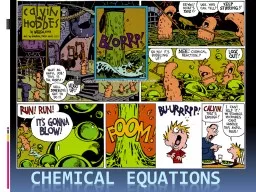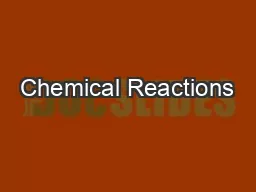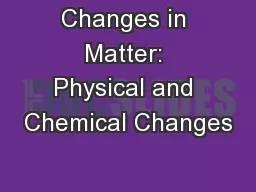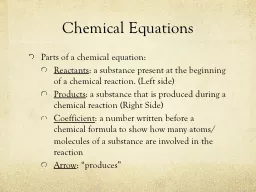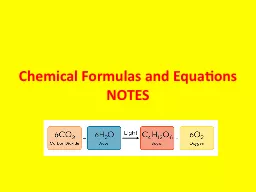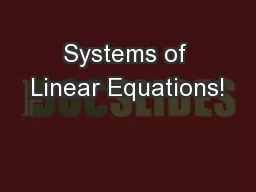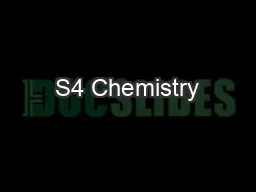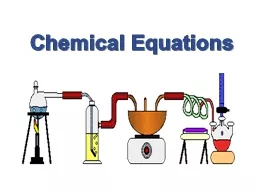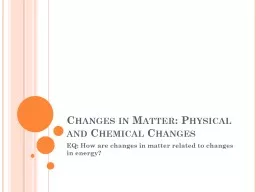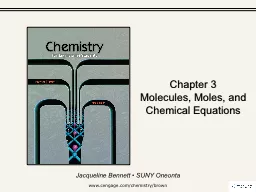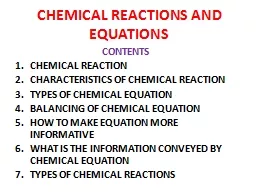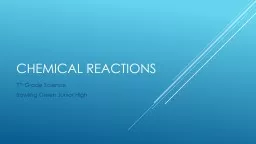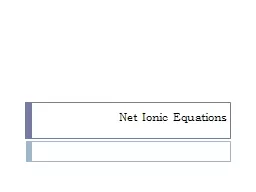PPT-CHEMICAL Equations
Author : sherrill-nordquist | Published Date : 2017-10-25
Chemical Changes vs Physical Changes Physical changes are changes in the physical appearance state or size of a substance Chemical changes are changes in the
Presentation Embed Code
Download Presentation
Download Presentation The PPT/PDF document "CHEMICAL Equations" is the property of its rightful owner. Permission is granted to download and print the materials on this website for personal, non-commercial use only, and to display it on your personal computer provided you do not modify the materials and that you retain all copyright notices contained in the materials. By downloading content from our website, you accept the terms of this agreement.
CHEMICAL Equations: Transcript
Chemical Changes vs Physical Changes Physical changes are changes in the physical appearance state or size of a substance Chemical changes are changes in the arrangements and connections between ions and atoms and a change in chemical properties. orgpublicinformationatefaqsgammaandexposurehtml It is a very good white paper by George Chabot CHP PHD that takes you from electric charge produced in the air by the photons to a usable equation and also explains where the simplified rule of thumb Rh Theme: . Changes and Reactions . LecturePLUS Timberlake. 2. color. melting point. boiling point. electrical conductivity. specific heat. density . state (solid, liquid, or gas). . EQ: How are changes in matter related to changes . in energy?. Changes in Matter. You are at the beach. You built a sandcastle!. You notice storm clouds gathering in the distance.. You are sad : (. You know your sandcastle is about to go bye-bye.. Parts of a chemical equation:. Reactants. : a substance present at the beginning of a chemical reaction. (Left side). Products. : a substance that is produced during a chemical reaction (Right Side). NOTES. MOLECULE. A . molecule. is . two . or more atoms that have chemically . combined.. Examples. : . H. 2. O. & O. 2. CHEMICAL FORMULA. A . Chemical Formula . is a description of the number and kind of atoms found in a single molecule of a substance, using the . By graphing. Definition. A system of linear equations, aka linear system, consists of two or more linear equations with the same variables.. x + 2y = 7. 3x – 2y = 5. The solution. The solution of a system of linear equations is the ordered pair that satisfies each equation in the system. . The Mole. REVISION. Formulae tell you how many of each atom are in a molecule.. Different atoms have different masses.. Level 4. NEW LEARNING. Formulae and balanced equations. Formula Mass and the mole. In a chemical reaction the total mass of everything at the end of the reaction is the same as the total mass at the beginning.. The Law of Constant Composition. However you make a compound, it always contains the same elements in the same proportions by mass.. Examples:. . 1). . . x 3 = 15. . 2) p – 5 = 20. 3) 2d = 16. 4). . = 24. . Multi-Step Equations. Examples—. 5). 2p 15 = 29. 6). 14 – 3n = -10. 7). 27 = -9(y 5). 8). 7a – 3a 2a – a = 16. EQ: How are changes in matter related to changes . in energy?. Changes in Matter. You are at the beach. You built a sandcastle!. You notice storm clouds gathering in the distance.. You are sad : (. You know your sandcastle is about to go bye-bye.. Chapter Objectives. Describe the chemical processes used in biomass production and conversion to biofuels.. Explain balancing a chemical reaction as an application of the . law of conservation of mass. CONTENTS. CHEMICAL REACTION. CHARACTERISTICS OF CHEMICAL REACTION. TYPES OF CHEMICAL EQUATION. BALANCING OF CHEMICAL EQUATION. HOW TO MAKE EQUATION MORE INFORMATIVE. Grade Science. Bowling Green Junior High. What are chemical reactions?. Chemical Reaction. . – . a change that takes place when two or more substances (reactants) interact to form new substances (products) with new properties.. Net ionic equations are useful in that they show only those chemical species directly . participating in . a chemical . reaction. The keys to being . able to . write net ionic equations are the ability to recognize monatomic and polyatomic ions, .
Download Document
Here is the link to download the presentation.
"CHEMICAL Equations"The content belongs to its owner. You may download and print it for personal use, without modification, and keep all copyright notices. By downloading, you agree to these terms.
Related Documents

